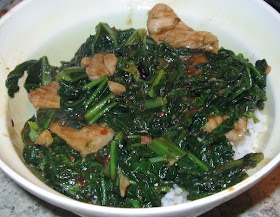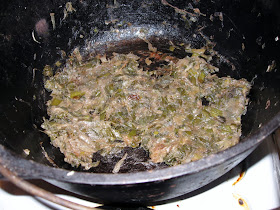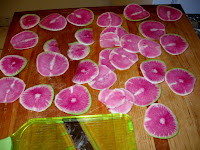One stir-fry and one cream soup. Normally, I'd just give them a passing mention in the weekly round-up, as they're simple stuff, but there are so few yukina recipes on the web that I wanted to put these out there for bewildered folks to find so they know a couple more options.
I separated the leaves and stems for these because I had two heads of yukina, both large enough for a full dish, and I wanted the variety. If you've got just one head, either one would work using the whole thing.
Let's start with the leaves.
Yukina savoy and pork stir fry
1/4 pound pork, sliced thin [I only had a center cut pork chop on hand which isn't the right cut for stir frying. Use something more tender, like loin.]
1 Tablespoon soy sauce
1 Tablespoon rice wine
2 teaspoons sugar
2 teaspoons cornstarch
1 bunch yukina savoy or leaves from 2, about a pound, cleaned
a few cloves garlic, minced
an equal amount ginger, minced
2 Tablespoons black bean sauce [I used black bean chili sauce since I like it hot]
1 Tablespoon peanut oil
1. Mix

the pork with a bit of soy sauce, a bit of rice wine, a little sugar and some cornstarch. Maybe some sesame oil. No need to measure precisely. Let marinate around 20 minutes.
2. Meanwhile,

stack the yukina leaves and slice them crosswise into ribbons about half an inch wide. If you're using the stems too, slice them into pieces a half inch wide too.
3. Get your garlic, ginger and black bean sauce ready.
4. Heat

a wok really really hot. Add the oil. Add the garlic, ginger and black bean sauce. Cook briefly until aromatic. Add the pork (along with the marinade) and stir fry until it loses its pinkness. Remove to a plate.
5. Add a little more oil to the wok, swirl it around then add the yukina. If you're using the stems, add them first, stir fry until mostly cooked, then add the leaves. Toss the leaves around a bit so they all gets somewhat wilted. When there's enough room, return the pork.

The yukina will be releasing some moisture (plus there will be some water still clinging to the leaves from when you washed them) so a sauce will start forming. As the cornstarch on the pork dissolves, it will start to thicken. It's pretty variable so add a little water if necessary or add a little more cornstarch (dissolved in an equal amount of water first) until the sauce is thick enough to cling to the leaves but not goopy. When you've gone from stir frying to simmering, turn down the heat to medium and cook until the leaves are tender.
Serve with white rice.

Yukina works pretty well here as it's sturdier than spinach, but doesn't need to cook nearly as long as, say, collards. Plus it's got enough flavor to stand up black bean sauce.
And now for the stems.
Cream of yukina savoy soup
1 bunch

yukina savoy or stems from 2, about a pound, cleaned
whatever other green vegetables you've got lying around [I used a spring onion and a couple handfuls of parsley leaves], chopped
1 large or 2 small potatoes [white or russet would likely be best], diced
1 Tablespoon butter
1 Tablespoon olive oil
4 cups chicken stock
1 cup cream [or sour cream or yogurt if you'd like it tangy]
salt and pepper and possible some other spices or herbs
1. Break the yukina stems into pieces no more than 5 inches or so long.
2. Add

the butter and olive oil to a dutch oven over medium-high heat. When the butter has finished foaming, add whatever vegetables you'd like to get a little color on, in my case the spring onion. After a bit I added the parsley. [Maybe parsley leaves taste good browned. Who knows?] If you're using the yukina leaves, you should probably wilt them down now.
2.

When the vegetables a softened and browned to your liking, add the potato and cook 2 minutes more. Add the yukina stems and the chicken stock. The vegetables should be just about submerged. If not, add more stock to cover. Bring to a boil, cover, reduce heat to medium low and simmer until everything is tender, around 10 minutes.

3. Remove everything to a large bowl and cool until you can get it into a blender without burning yourself, around another 10 minutes.
4. Blend

well in batches, straining the blended soup back into the dutch oven. Yukina stems tend to be stringy, so even with serious blending, I had to strain out a good wad of gunk.
5. Add the cream and season to taste. Now's the time to add any additional flavors that you think might go well with what you've got so far. I added some pimenton which I though went nicely with the celery notes in the soup.
6. Put the pot back on the heat and bring back up to serving temperature.
You probably ought to garnish it because otherwise it looks like this:

I should have saved a little spring onion to sprinkle on top.
My soup ended up tasting somewhere between cream of cabbage and cream of broccoli. Not what I expected, but pretty good. And, like both those soups, tasty served cold too.
Like I said up top, nothing groundbreaking here, but both successful applications of yukina. If you're not sure what to do with yours, I can recommend either strategy.

 the cilantro, garlic, peppercorns, pepper flakes, salt and fish sauce until smooth. Add a little chicken stock to get everything moving around in the food processor. Remove to a large bowl, and stir in the rest of the stock. Add the rice flour gradually until a smooth loose batter forms. Add a little water if it gets too thick.
the cilantro, garlic, peppercorns, pepper flakes, salt and fish sauce until smooth. Add a little chicken stock to get everything moving around in the food processor. Remove to a large bowl, and stir in the rest of the stock. Add the rice flour gradually until a smooth loose batter forms. Add a little water if it gets too thick. the chicken, coat well and refrigerate overnight.
the chicken, coat well and refrigerate overnight. oil to 350 and fry around 5 minutes on each side until the center of the meet reaches 160 degrees. It should be more of a copper than a golden brown. [I had trouble cooking the chicken through before the crust burnt with my later batches so watch your oil temperature.]
oil to 350 and fry around 5 minutes on each side until the center of the meet reaches 160 degrees. It should be more of a copper than a golden brown. [I had trouble cooking the chicken through before the crust burnt with my later batches so watch your oil temperature.]
 I also made a leek pie as planned, sort of. I decided to use sliced potatoes for the crust but I sliced too many and put a layer in the middle too so it was sort of a gratin. Plus I added a couple eggs to the cream and cheese the recipe called for so it's sort of a quiche too. It's interesting enough for a post, but I didn't measure anything or take pictures while I was making it so I don't think it would work.
I also made a leek pie as planned, sort of. I decided to use sliced potatoes for the crust but I sliced too many and put a layer in the middle too so it was sort of a gratin. Plus I added a couple eggs to the cream and cheese the recipe called for so it's sort of a quiche too. It's interesting enough for a post, but I didn't measure anything or take pictures while I was making it so I don't think it would work. 
















































